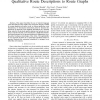Free Online Productivity Tools
i2Speak
i2Symbol
i2OCR
iTex2Img
iWeb2Print
iWeb2Shot
i2Type
iPdf2Split
iPdf2Merge
i2Bopomofo
i2Arabic
i2Style
i2Image
i2PDF
iLatex2Rtf
Sci2ools
IROS
2006
IEEE
2006
IEEE
Robot Navigation based on the Mapping of Coarse Qualitative Route Descriptions to Route Graphs
— This paper describes the use of natural language route descriptions in the mobile robot navigation domain. Guided by corpus analysis and earlier work on coarse qualitative route descriptions, we decompose instructions given by humans into sequences of imprecise route segment descriptions. By applying fuzzy rules for the involved spatial relations and actions, we construct a search tree that can be searched in a depth-first branchand-bound manner for the most probable goal configuration w.r.t. the global workspace knowledge of the robot. The applicability of our approach is shown by a real-world experiment where an operator instructs his automated wheelchair to navigate in an office-like environment.
| Added | 12 Jun 2010 |
| Updated | 12 Jun 2010 |
| Type | Conference |
| Year | 2006 |
| Where | IROS |
| Authors | Christian Mandel, Udo Frese, Thomas Röfer |
Comments (0)

